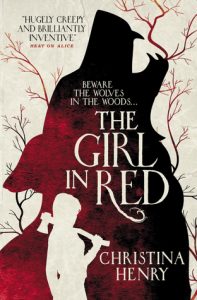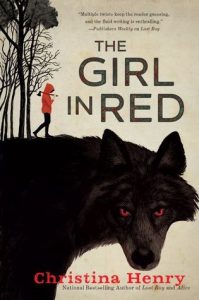The Girl in Red by Christina Henry (Book Review)
 I have always enjoyed glimpsing the subtle nuances and influences by which one story’s DNA might have intruded into another, much more so than the bland and predictable gleanings of the ‘trace your ancestry’ genetic websites. So I approach the idea of a re-imagined fairy tale with more enthusiasm than some of my peers, eager to see how the raw steel of a Grimms’ fairy tale might be reforged into an edge sharp enough for contemporary fiction. I have been entertained by Mark Lawrence’s version of Sleeping Beauty, which took a sideswipe at other tales as Jorg and his companion trekked through a forest. I also thrilled at Mercedes Murdoch Yardley’s dark retelling of a classic in her award-winning short story “Little Dead Red.” So I was hungry to see what Christina Henry would achieve in a work described as a ‘dark retelling of Little Red Riding Hood.’
I have always enjoyed glimpsing the subtle nuances and influences by which one story’s DNA might have intruded into another, much more so than the bland and predictable gleanings of the ‘trace your ancestry’ genetic websites. So I approach the idea of a re-imagined fairy tale with more enthusiasm than some of my peers, eager to see how the raw steel of a Grimms’ fairy tale might be reforged into an edge sharp enough for contemporary fiction. I have been entertained by Mark Lawrence’s version of Sleeping Beauty, which took a sideswipe at other tales as Jorg and his companion trekked through a forest. I also thrilled at Mercedes Murdoch Yardley’s dark retelling of a classic in her award-winning short story “Little Dead Red.” So I was hungry to see what Christina Henry would achieve in a work described as a ‘dark retelling of Little Red Riding Hood.’
At first glance, Christina Henry’s links to the fairy tale that inspired it are loose. There is a girl called Red. She wears a red sweatshirt with a hood. She is travelling through (several) forests to grandma’s house, and an axe does make an appearance at several points in the story.
But essentially this is an apocalypse story. I remember the ground-breaking BBC TV show “Survivors” from the 1970s, in which a plague swifter and more lethal than the Black Death has reduced humanity to a few isolated survivors. A low budget and limited special effects meant it couldn’t show the sweeping panorama of a devastated London that we saw in ’28 Days Later,’ but it still felt fresh and engaging. In The Girl in Red, Red’s world has been shattered by a plague, sending her on a long lonely trek to the sanctuary of Grandma’s well-stocked and hidden home. But, unlike Red Riding Hood, the predators who haunt Red are more of the two-legged variety – the usual perils seen in many cinematic depictions of a breakdown of society.
Contemporary fiction cannot ignore the fact that apocalypse stories have become ingrained in popular culture – a fact that bleeds into The Girl in Red with Red’s preparedness for the catastrophe that has overwhelmed the world. She directly attributes many of her survival strategies to gleanings from films. It’s not discoveries on google that drive her decisions so much as errors she has seen characters commit in “28 Days Later” and other films. This self-referencing of apocalypse fiction could grate, but in Henry’s hands it actually feels more real. I’m sure many of us would recognise the kind of conversations Red has with her family. I mean, I’m sure ours isn’t the only family to arrive at each new holiday resort and immediately discuss how survivable it would be in the event of a zombie apocalypse (or maybe it is just us).
 Red (Delia to her parents, Cordelia to her mother when she’s been especially naughty) is a far more capable and independent heroine than her fairy tale namesake. However, that is too-faint praise given Little Red Riding Hood couldn’t tell the difference between an old woman and a wolf in grandma’s clothing. Red is a woman of mixed race, ambivalent sexuality, and she has an artificial leg. The constraints of the artificial leg feature strongly, as one might expect, on her 300-mile journey to grandma’s house; and it seems prejudice hasn’t died quite as quickly as three quarters of the population, so adding to Red’s perils. I warmed to Henry’s portrayal of her character’s disability, describing it with the same no-nonsense pragmatism that the girl herself displays. The artificial leg is part of her and part of the story – not a bolt-on plea for pity, or a token afterthought like a certain revered wizard’s retrofitted sexuality. More particularly, the impact of Red’s car-crash-induced disability is far more credibly described than, for example, Kiernan Shipka’s deaf character in The Silence.
Red (Delia to her parents, Cordelia to her mother when she’s been especially naughty) is a far more capable and independent heroine than her fairy tale namesake. However, that is too-faint praise given Little Red Riding Hood couldn’t tell the difference between an old woman and a wolf in grandma’s clothing. Red is a woman of mixed race, ambivalent sexuality, and she has an artificial leg. The constraints of the artificial leg feature strongly, as one might expect, on her 300-mile journey to grandma’s house; and it seems prejudice hasn’t died quite as quickly as three quarters of the population, so adding to Red’s perils. I warmed to Henry’s portrayal of her character’s disability, describing it with the same no-nonsense pragmatism that the girl herself displays. The artificial leg is part of her and part of the story – not a bolt-on plea for pity, or a token afterthought like a certain revered wizard’s retrofitted sexuality. More particularly, the impact of Red’s car-crash-induced disability is far more credibly described than, for example, Kiernan Shipka’s deaf character in The Silence.
The plot is fundamentally an apocalyptic disaster movie in book form. I don’t see these very often – I Am Legend and The Girl With All the Gifts are the only ones that spring immediately to mind, and World War Z – as a book, at least – was far more of a collection of entertaining historical chronicles than an out-and-out novel. This does mean that some elements of The Girl in Red’s plot feel familiar if not exactly predictable. There are other aspects of the story where the fairy tale foundation stretches more perceptibly into the tale – not just Little Red Riding hood, but even a touch of Hansel and Gretel. While some of these work well, others jar a little. One element in particular felt a little shoe-horned from the fairy tale into a story which struggled to contain it without bursting. Not that this spoilt my enjoyment; the story cracked along at a good pace and I just had to accept it and run with it.
At another time, Henry’s protagonist twice accuses a character of being her deus ex machina – a bold step for both character and author, though the story sustains it well. Certainly the character in question is no more a deus ex machina than the original Red Riding Hood’s friendly woodsman. The end, when it came, appeared a bit suddenly and is perhaps indicative of the relative weaknesses in the plot, but I found much to admire in the pace and quality of writing. There were lots of lines that caught my eye, these amongst them:
On meeting a stranger in the woods:
“They were not going to be friends, then. Red did not feel sad about this.”
Or later:
“She crept toward the one window as quietly as she could, which was not very quietly because there were dry dead leaves all around the clearing that seemed as loud as firecrackers in the still air.”
“Red found it hard not to take the Sun’s lack of warmth personally.”
Or thinking back to before:
“Her very first babysitting-money purchase was a bright red hooded sweatshirt with a zip up the front, and she earned that sweatshirt because the deLuccis had four boys between the ages of two and eight and that job was as awful as it sounds.”
The chapters alternate between the “after” and the “before” in a way that reminded me of the film ‘Birdbox.’ We meet Red alone by her fire in the forest; at the same time as Henry carries her forward from this point, she flicks back in time to show the steps by which Red became separated from her family. These twin timelines work very effectively and, while the story was slow to grab me at first, once it had its teeth in me it wasn’t letting go. I started and finished it in under a day.
Even as I write this, it strikes me that the story could still have a sudden twist just beyond its ending. After all, apocalyptic movies can never have that unambiguous happy ending, and I am seized by sudden doubt for Red – perhaps as Christina Henry intended.
THE GIRL IN RED will be released on June 18th 2019. You can pre-order it here.

I loved this too, awesome review?